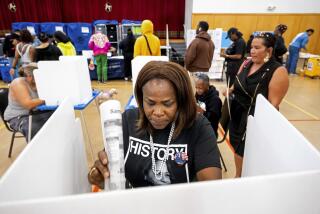Millions lose access to polls, have votes go uncounted, report says
- Share via
The journey toward election reform that began with the hotly contested presidential election of 2000 is “less than halfway complete,” according to a group of scientists, who on Thursday urged the shoring up of old problems and a go-slow approach on innovations like mail-in voting.
The comprehensive report by the Caltech-MIT Voting Technology Project said millions of voters continued to lose access to the polls or have their votes uncounted because of technological and procedural shortfalls. The group recommends more study, attention and government investment to solve the problems.
“Unfortunately, the nation has not always had the patience to sustain and fully implement reforms, and election reform is no exception,” the report said. “Today, new challenges in elections have arisen that, if not addressed, could result in an eventual constitutional crisis just as critical as that following the 2000 presidential election.”
A dispute over the counting of contested ballots in Florida that year went all the way to the U.S. Supreme Court, which voted 5 to 4 to end a state recount, effectively putting Texas Gov. George W. Bush in the White House.
The Caltech-MIT researchers noted the growing phenomenon of “guaranteed” absentee voting — in which citizens do not have to show cause to vote before election day — and voting by mail. Those trends have grown despite the lack of research into potential pitfalls.
“Fraud and security are related to the physical protection of the ballot, and the ease with which absentee ballots can be intercepted or bought and sold,” the report said. “It remains the case that having tens of millions of ballots being transmitted and marked without strict chain-of-custody procedures creates risks that simply do not exist with any form of in-person voting, whether on election day or in early-voting settings.”
The scientists said they “discourage the continued rise of no-excuse absentee balloting and resist pressures to expand all-mail elections” and felt the same way about Internet voting, until those systems can be better audited and the Internet voting risks “sufficiently mitigated.”
While real problems loom in those emerging vote systems, the voting experts described as overblown complaints about massive voter fraud and the need to root it out with voter identification requirements.
“There simply is not a strong record demonstrating the prevalence of voter impersonation fraud or voting by ineligible individuals — the types of fraud that strong voter identification requirements might mitigate,” they wrote.
States that have imposed a photo identification requirement still have not found a way to do so without leaving many voters, especially minorities, without proper ID. And the rules are unevenly applied, because those who vote by mail don’t have to follow them.
That view has been upheld in recent court cases, notably in Ohio, where election officials are now required to allow voters to proceed without identification.
The report suggests that the state could maintain photos of voters at polling places and build those collections, perhaps, by photographing those who didn’t already have a driver’s license or other ID on record.
Some improvements have been made since the histrionics of 2000. The “residual vote” — ballots turned in but with votes missing — declined from 2% of all ballots in 2000 to 1% in the 2006 and 2008 elections.
States have replaced problematic punch-card and lever machines that had high failure rates and also adopted statewide computerized voter registration. Provisional balloting systems — allowing voters to cast ballots even when their registration is contested — have advanced but not far enough, the study said. (Provisional ballots only get counted later, when the voters’ registrations are confirmed.)
That’s just one example of one of many voting issues that the scientists said needed more attention and more investment. They noted that the commitment was in danger of slipping in the opposite direction.
Follow Politics Now on Twitter and Facebook
Twitter: @latimesrainey
MORE COMMENTARY FROM JAMES RAINEY:
The main difference in Debate no. 2? Obama punched back
Biden, Ryan debate won’t decide things for either side
Furor over Crowley ignores her record
More to Read
Get the L.A. Times Politics newsletter
Deeply reported insights into legislation, politics and policy from Sacramento, Washington and beyond. In your inbox twice per week.
You may occasionally receive promotional content from the Los Angeles Times.










